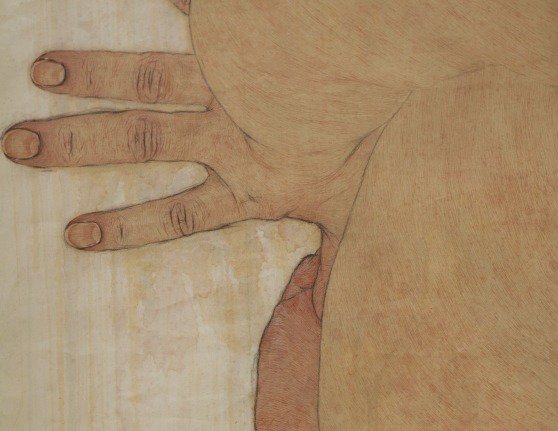Seung Ah Paik
dal 31/1/2013 al 22/3/2013
Segnalato da
31/1/2013
Seung Ah Paik
Lubomirov-Easton, London
Autolandscape. Painted on unbleached calico and installed as a series of large-scale banners or drapes, Seung Ah Paik's self-portraits involve viewers in an intimate, immersive experience of the female body.

Painted on unbleached calico and installed as a series of large-scale banners or drapes, Seung Ah Paik’s self-portraits involve viewers in an intimate, immersive experience of the female body. In Autolandscape, the humble familiarity of a wrinkled hand or calloused heel gives way to unfolding limbs, mounded curves, a sudden precipice of empty, unpainted space. Horizons emerge from contoured flesh; detailed and seen from the ‘eye of the beholder’, a thigh becomes a mountain range. The experience of looking at these paintings is giddying, exhilarating. Uncanny.
This is the viewpoint from which we see our own bodies, as something close and distant, minute and vast, pitifully insignificant, magnificent and epic. Seung Ah’s work captures the sense of perpetual movement between these endlessly different perspectives, which come in and out of view as we breathe and shift within our own skins.
As self-portraits these works are concerned not with self-image but with self-embodiment and how painting can materially express the experience of self. Here is the female body, mortal and splendid, but tenanted - occupied rather than objectified. As nudes these images resist the female objectification inscribed in Western tradition by asserting mutability and the freedom that comes with this. Drawing on techniques used in traditional oriental landscape painting, Seung Ah creates multiple or ‘floating’ perspectives, which deflect the single ‘authoritative’ viewpoint.
Seung Ah talks about the impossibility of seeing one’s own face directly – it will always be as a reflection or captured image. To paint her own face seemed a distortion, a pretence, so she started with her hands and feet, the parts we are most familiar with but often disregard. She found her hands wrinkled, old looking, gnarled even, her feet hardened and dry. Setting out to capture their ugliness she used oriental portrait painting techniques, inscribing fine lines to describe and define contours or ‘pattern the logic of the flesh’, and in doing so made works that seemed to celebrate. “These are my tools!” she smiles, examining her hands once again.
This ambivalence pervades the work. “I wanted my skin to be present in the painting,” she explains, and here it is. The paintings are pinned directly to the gallery walls and fabric pools on the floor into crinkled piles of excess material, like shrugged off tissue or unwanted hide. Skin is physically conjured here in the painted fabric as enticing, luxuriant, delicious but also potentially grotesque. Using water based pigments, Seung Ah layers translucent stains onto fabric to create opaque flesh tones, a process in which drips seep beyond the drawn outlines, like fluid escaping the body’s boundaries to deliquesce into the surrounding empty spaces of calico.
When the paintings are inverted and hung for display there are moments when the drip marks ascend in small, stylised forms suggestive of the mountain ranges painted in traditional oriental landscape. Seung Ah shows me a reproduction of the 15th C ‘Dream Journey to the Peach Blossom Paradise’ painted by Korean artist An Kyun. It uses high, flat and deep distance perspectives to convey the various stages of the dream journey across the mountainous landscape to paradise. This is a meditational painting through which the viewer could achieve Wa-yu or ‘rambling while lying’, a spiritual encounter with the mountains from their own room.
Similarly Autolandscape offers us the experience of travelling without moving; we encounter the body as a landscape of great familiarity and strangeness, a place we inhabit but can never fully know - which is the start and end point of every human journey. These paintings have a candour and directness and, for all their larger than life presence, a quality of fragility; an aesthetic of delicacy, subtlety and economy has informed their making.
Opening: 1st February 2013
Lubomirov-Easton
50 Resolution Way, Deptford, London
Hours: Wednesday to Saturday, 12-6pm
Free Admission



